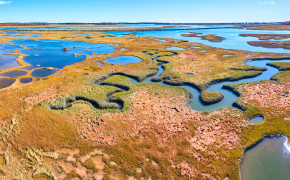Representative Matters
Parker’s experience includes:
- Serving as lead Endangered Species Act (ESA) litigation counsel to defend nine of the world’s top tire manufacturers and distributors against a sweeping citizen suit alleging unauthorized take of 24 different salmonid species in streams and rivers across the western U.S.
- Serving as lead wetlands permitting and ESA counsel to the developers of a world-scale $8.5 billion integrated polymers facility in east Texas. When completed, the 1,800-acre plant will be one of the largest in the world – consisting of 50 modules, an ethylene cracker unit, two high-density polyethylene units, and marine and rail components – and will have a processing capacity of 2.08 million tons per annum.
- Serving as lead ESA regulatory and litigation counsel to the developers of a $7 billion interstate natural gas pipeline in the MidAtlantic U.S. Responsible for developing the ESA Section 7 consultation strategy for 15 separate listed species – including endangered bats, freshwater mussels, fish, and plants – identifying workable and effective conservation measures, and designing defensible monitoring protocols. Project construction is scheduled to conclude in mid-2024.
- Serving as primary ESA litigation and regulatory counsel to defend a leading biomedical company against citizen suits alleging unauthorized take of protected species from the production of endotoxin testing products which are crucial to ensuring the safety of the global supply of medical injectables.
- Serving as lead wetlands permitting and National Environmental Policy Act (NEPA) counsel to the developer of a $1.6 billion 16,000-acre Texas reservoir designed to meet the drinking and commercial water needs of 2.2 million residents of the country’s fastest-growing counties. After experiencing eight years of agency delays and EPA attempts to prospectively veto the project’s Clean Water Act (CWA) Section 404 permit, the developer engaged Parker to identify and implement a new permitting and NEPA strategy capable of securing the permit on an expedited schedule. Under that new strategy, EPA rescinded its threatened veto, and the U.S. Army Corps of Engineers (USACE) completed a revised NEPA analysis and issued the Section 404 permit to the developer in February 2018. That Section 404 permit stands as one of the largest issued by the USACE in nearly 25 years – authorizing the inundation of almost 6,000 acres of wetlands and 125 miles of streams, and requiring over 21,000 acres of mitigation. Construction of the Bois d’Arc Lake reservoir was completed on October 14, 2022.
- Serving as common counsel to nine upstream and midstream oil and natural gas companies in the development of one of the largest habitat conservation plans in the history of the ESA, designed to authorize the incidental take of five bat species associated with project development across three states for a period of 50 years.
- Serving as ESA and NEPA counsel to energy industry clients in the development of the Nationwide Candidate Conservation Agreement with Assurances for Monarch Butterfly on Energy and Transportation Lands.
- Serving as coalition counsel to national trade associations to address ESA listing decisions with the U.S. Fish and Wildlife Service (FWS).
- Assisting federal lawmakers in drafting legislation to streamline project development under NEPA, reform the ESA, and expedite the CWA permitting process.
- Defending one of North America’s leading railroad companies against the largest CWA citizen suit in U.S. history, with claimed damages of $4 trillion, leading to successful resolution of alleged unpermitted discharges of coal from railcars to waterbodies and wetlands throughout Washington State.
- Representing members of the oil and gas industry in the development of one of the first ever general conservation plans under the ESA to authorize incidental take of listed species.
- As an appointed special Attorney General, helping state Departments of Transportation and other state agencies build administrative records to support crucial infrastructure projects and successfully defend them against citizen suits under NEPA, Section 404 of the CWA, and the ESA.
- Developing unique protocols approved by the FWS for oil and gas companies to advance projects without first obtaining incidental take permits under the ESA.
- On behalf of a Fortune 200 company, negotiating the settlement of the second largest CWA enforcement action in Virginia history.
- Successfully defending a $250 million Kansas intermodal facility and its wetlands permit against a citizen suit challenge under the CWA and NEPA.
- Defending an international wireless telecommunications company against federal criminal investigations for alleged violations of the ESA, the Migratory Bird Treaty Act, and the Bald and Golden Eagle Protection Act, resulting in a declination of prosecution by the U.S. Department of Justice.
- Authoring a pivotal U.S. Supreme Court amicus brief cited approvingly by Justice Scalia in the controversial wetlands regulation case, Rapanos v. United States.









